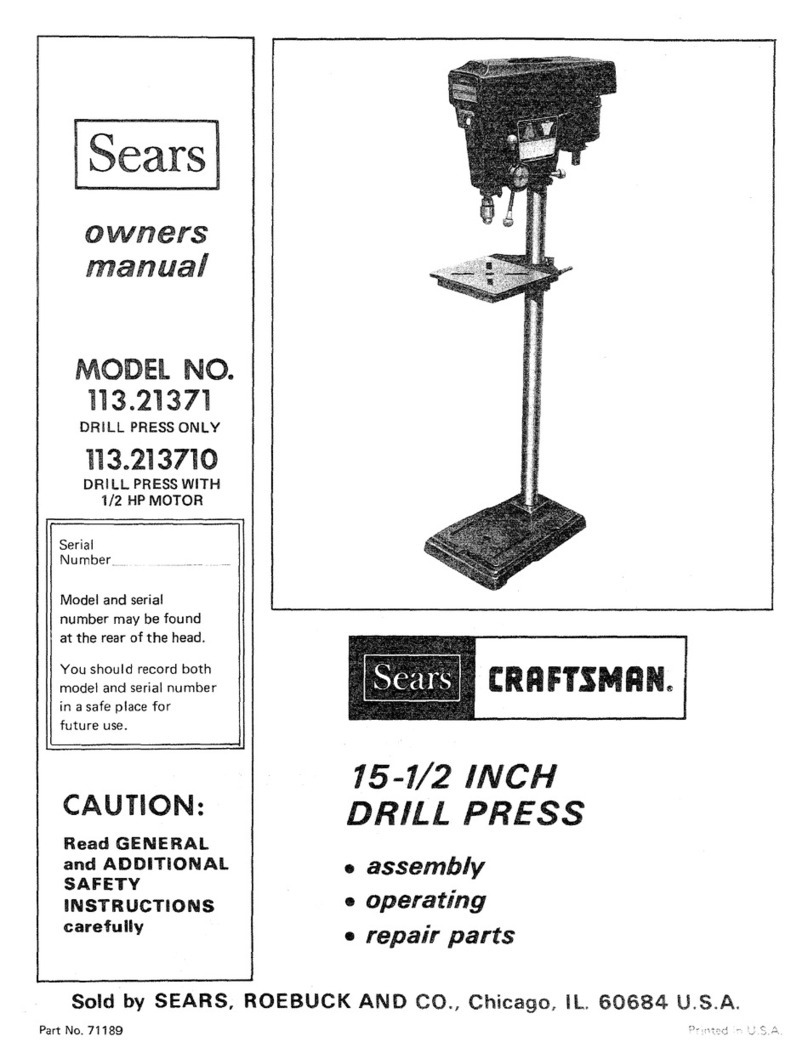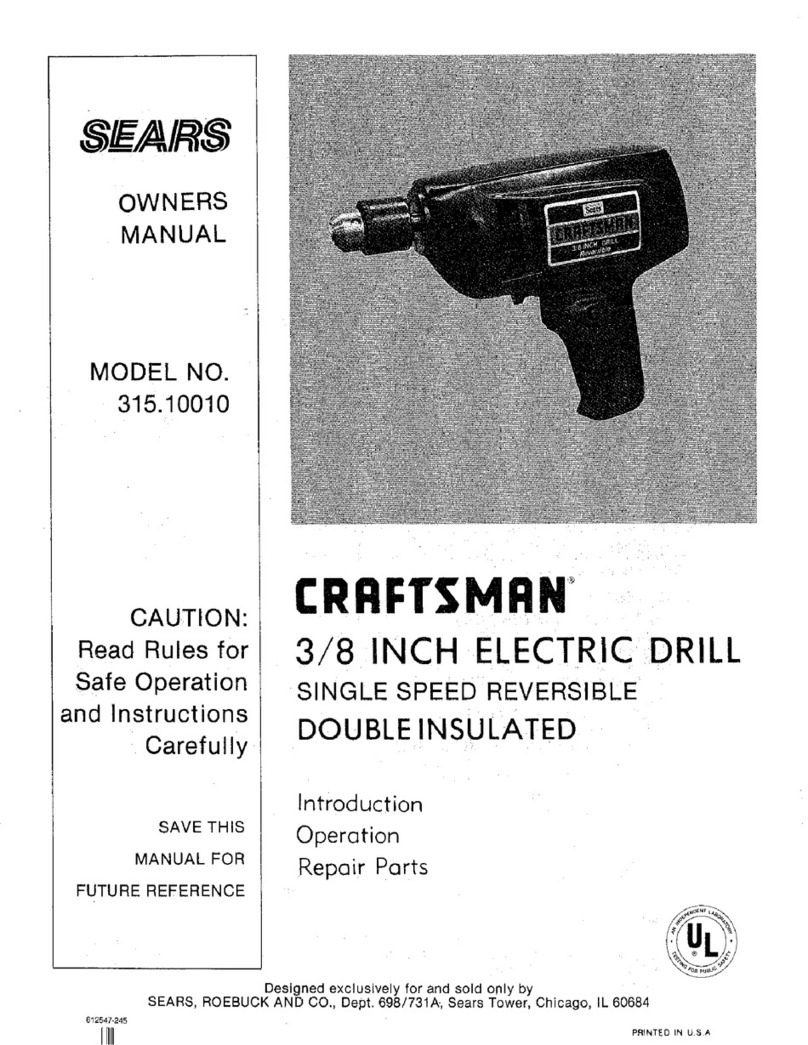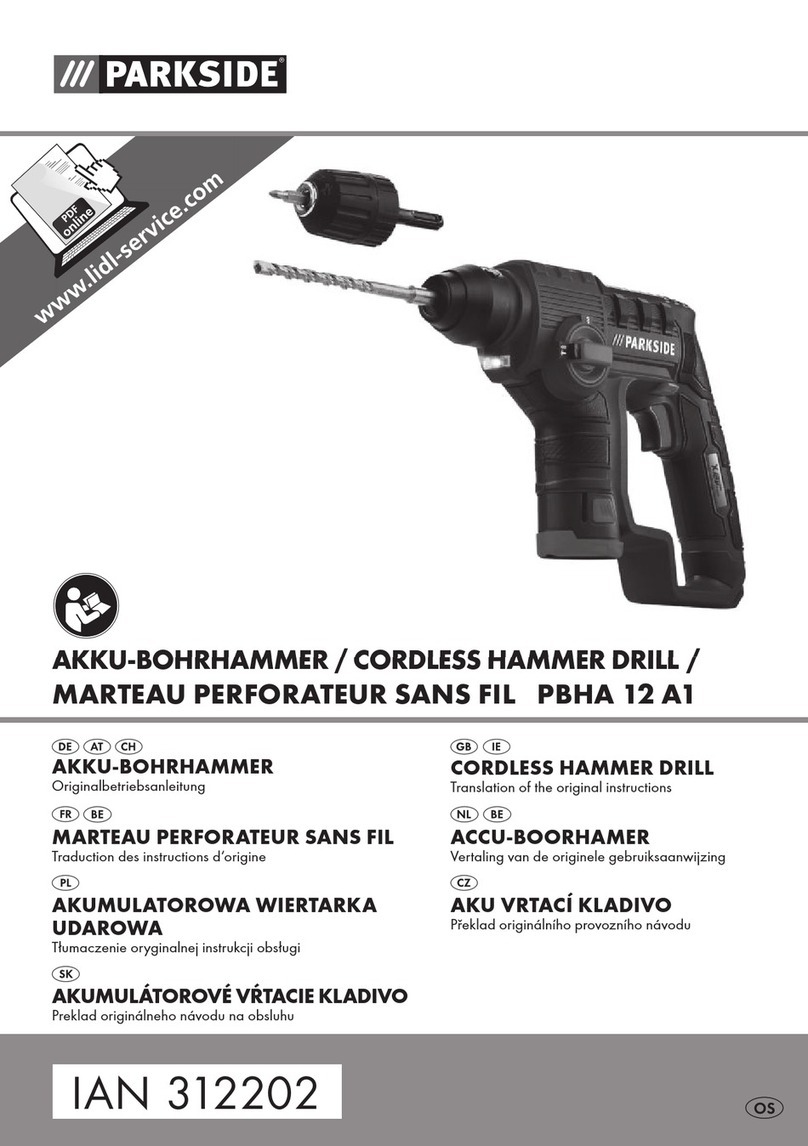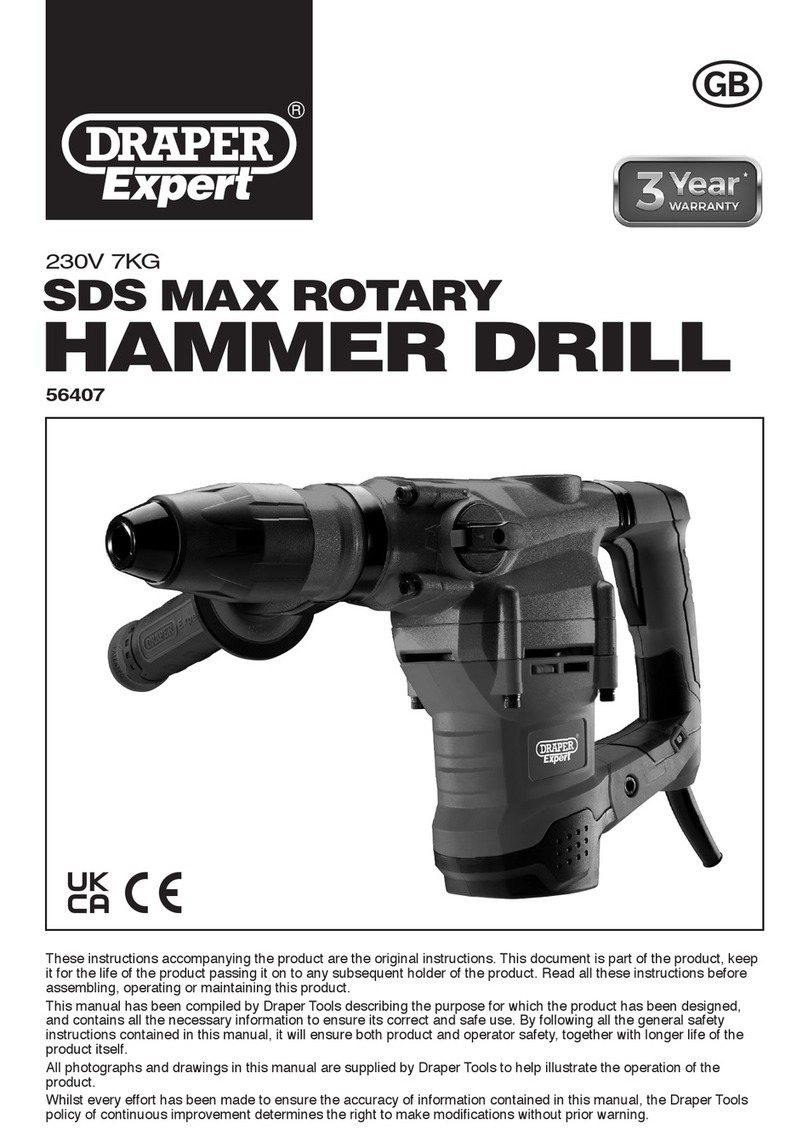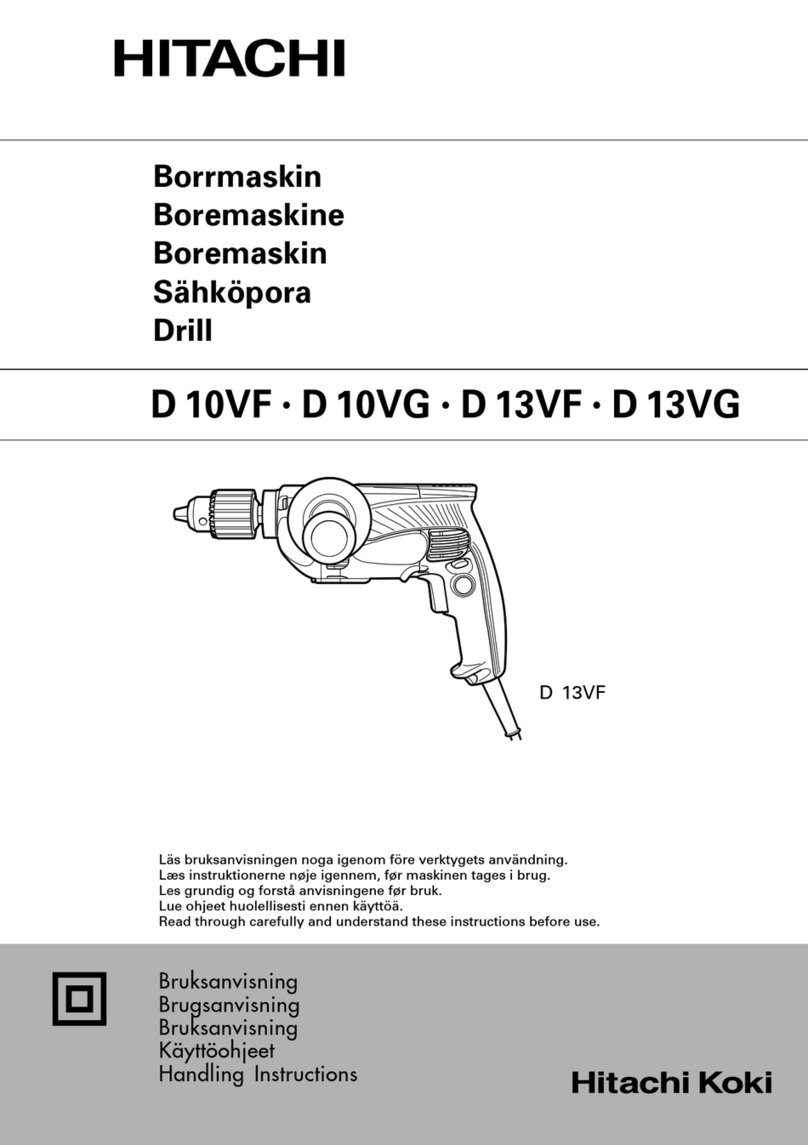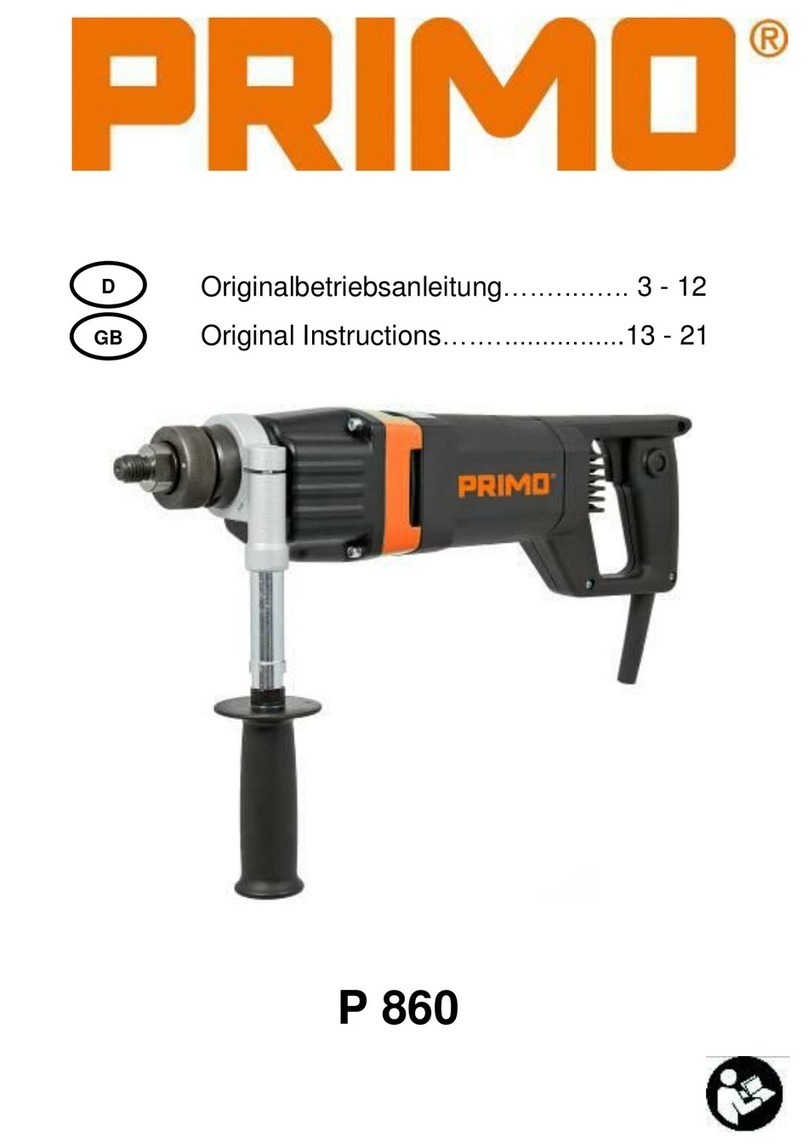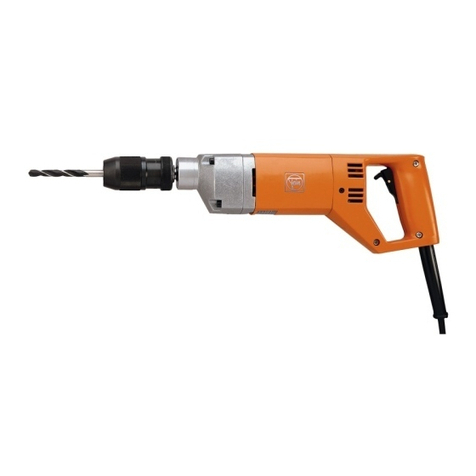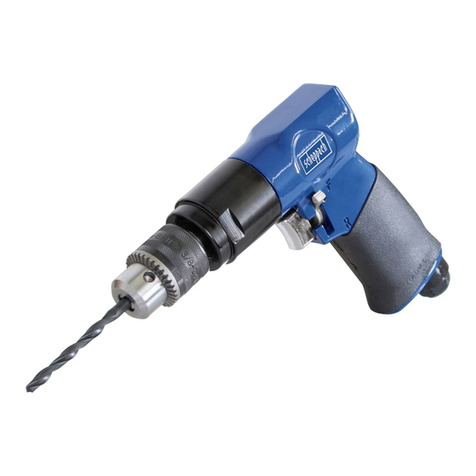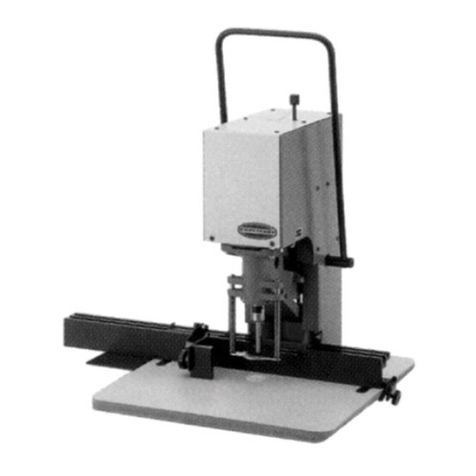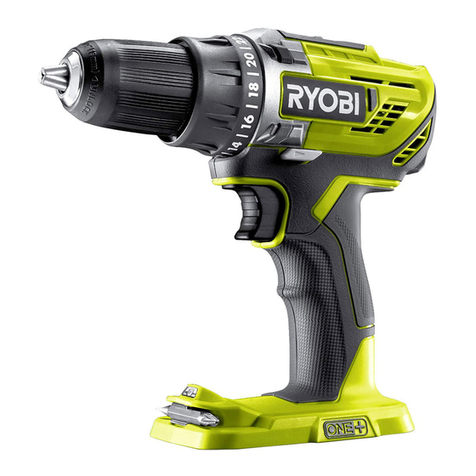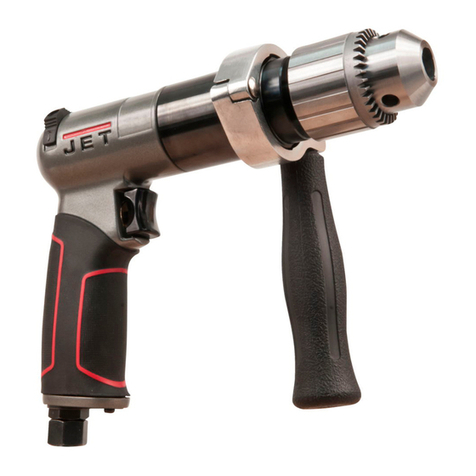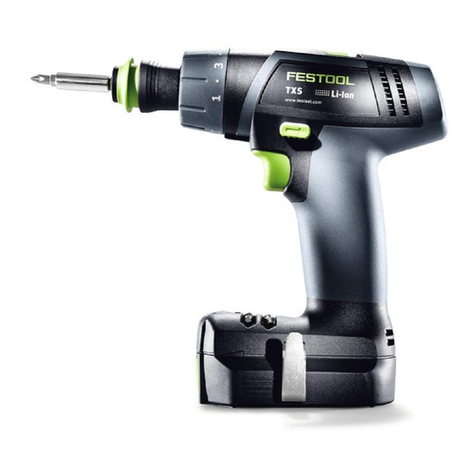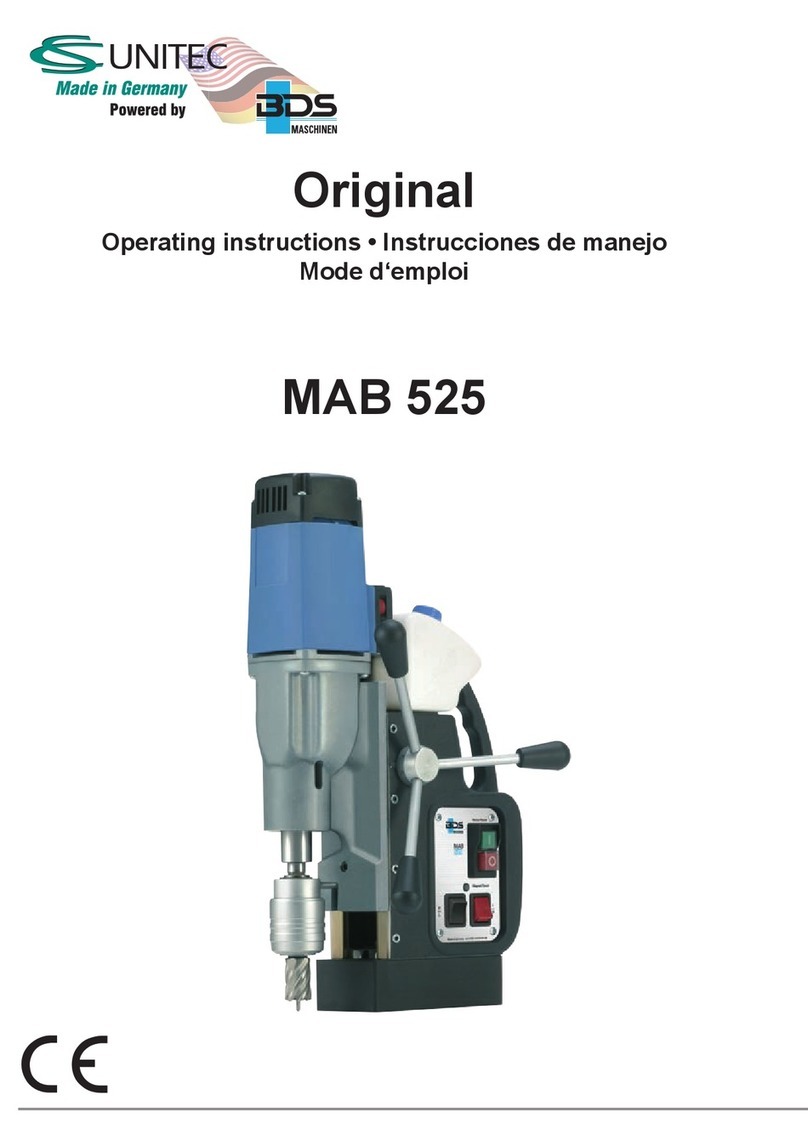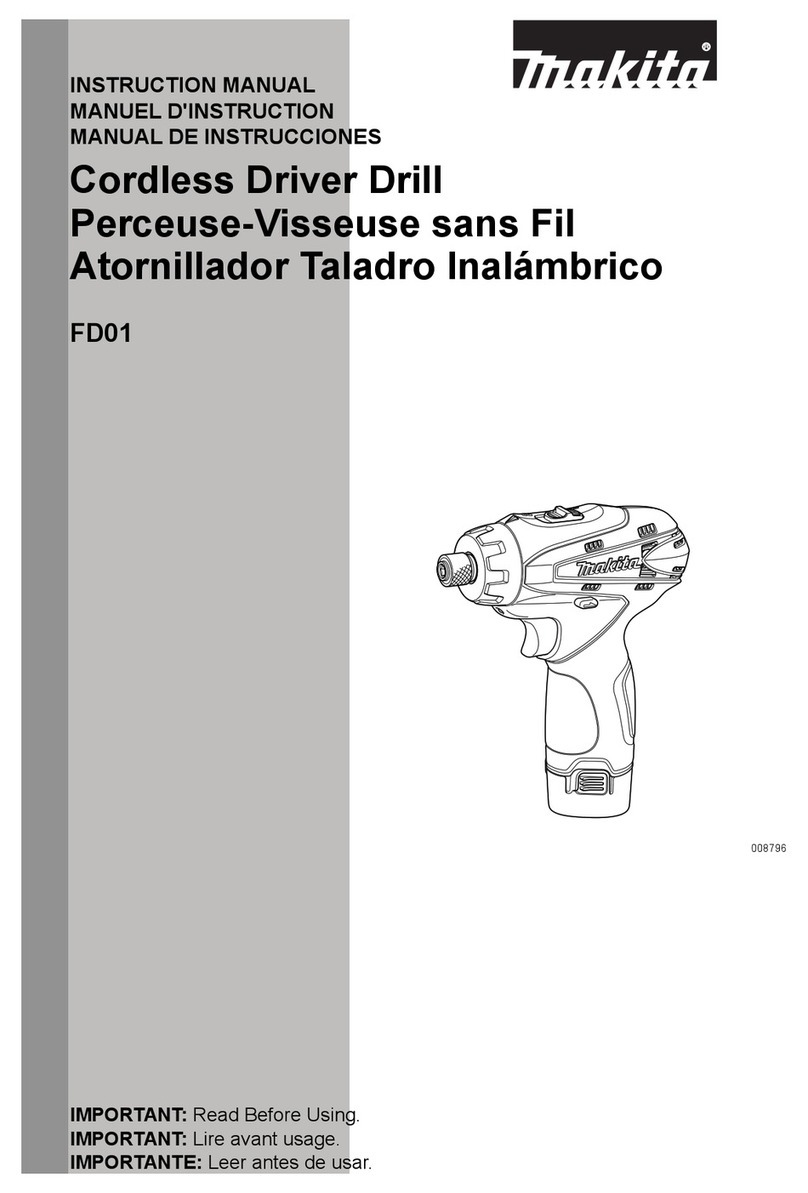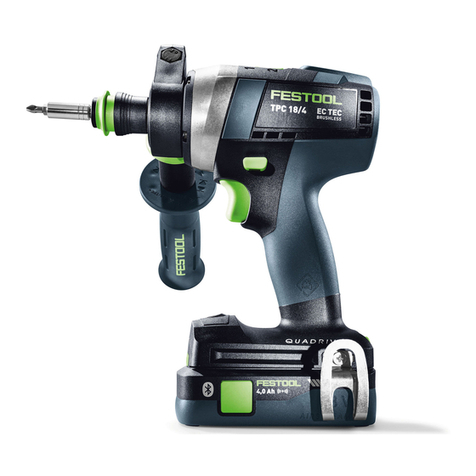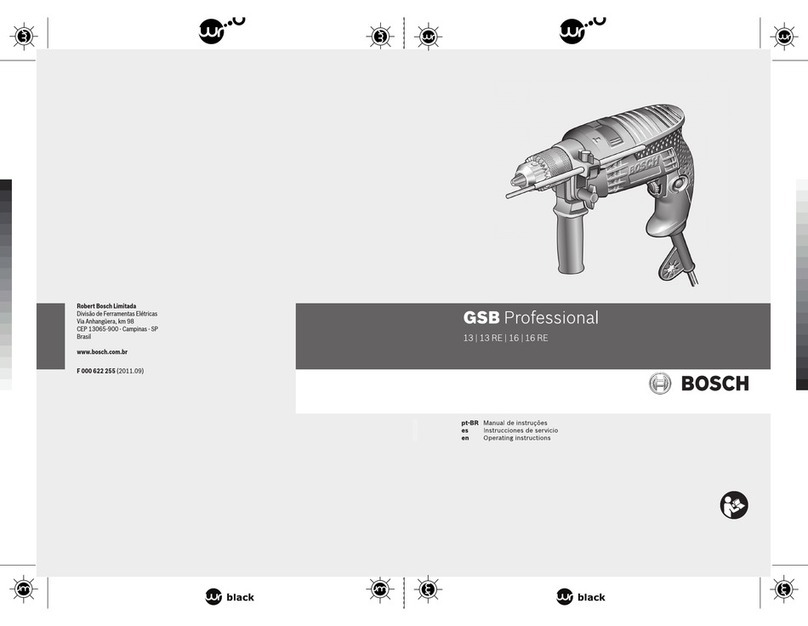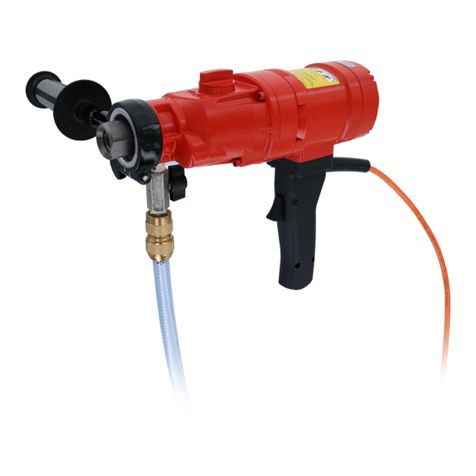Sears CRAFTSMAN 315.DD2100 User manual

990000245
8-21-12 (REV:02)
1/2 in., 19.2 VOLT 2-SPEED DRILL-DRIVER
VARIABLE SPEED/REVERSIBLE
TALADRO-DESTORNILLADOR DE 19,2 V
13 MM (1/2 PULG.) DOS VELOCIDADES
Model No. / Número de modelo
315.DD2100
OPERATOR’S MANUAL
MANUAL DEL OPERADOR
Save this manual for future reference
Guarde este manual para futuras consulta
WARNING: To reduce the risk of injury,
the user must read and understand the
operator’s manual before using this
product.
Customer Help Line: 1-800-932-3188
Teléfono de atención al consumidor: 1-800-932-3188
Sears Brands Management Corporation, 3333 Beverly Rd., Hoffman Estates, IL 60179 USA
Visit the Craftsman web page: www.sears.com/craftsman
Visite el sitio web de Craftsman: www.sears.com/craftsman
ADVERTENCIA: Para reducir el
riesgo de lesiones, el usuario debe leer
y comprender el manual del operador
antes de usar este producto.
LOC
K

2
ENGLISH
Warranty......................................................................2
Introduction.................................................................2
General Power Tool Safety Warnings ..................... 3-4
Drill-Driver Safety Warnings........................................4
Symbols ......................................................................5
Features ......................................................................6
Assembly ....................................................................6
Operation ................................................................ 7-9
Maintenance .............................................................10
Exploded View and Parts List...................................11
Figure numbers (illustrations).................................. ii-iii
Parts Ordering / Service.............................. Back Page
TABLE OF CONTENTS / ÍNDICE DE CONTENIDO
WARRANTY / GARANTÍA
INTRODUCTION / INTRODUCCIÓN
This tool has many features for making its use more pleasant and enjoyable. Safety, performance, and dependability
have been given top priority in the design of this product making it easy to maintain and operate.
* * *
Esta herramienta ofrece numerosas características para hacer más agradable y placentero su uso. En el diseño de
este producto se ha conferido prioridad a la seguridad, el desempeño y la fiabilidad, por lo cual se facilita su manejo y
mantenimiento.
CRAFTSMAN®ONE YEAR LIMITED WARRANTY
FOR ONE YEAR from the date of purchase, this product is warranted against any defects in material or workmanship.
With proof of purchase, defective product will be replaced free of charge.
For warranty coverage details to obtain free replacement, visit the web site: www.craftsman.com
This warranty does not cover bits which are expendable part(s) that can wear out from normal use within the warranty
period.
This warranty is void if this product is ever used while providing commercial services or if rented to another person.
This warranty gives you specific legal rights, and you may also have other rights which vary from state to state.
Sears Brands Management Corporation, Hoffman Estates, IL 60179
* * *
GARANTÍA LIMITADA DE CRAFTSMAN POR UN AÑO
Este producto tiene garantía por cualquier defecto en material o mano de obra DURANTE UN AÑO desde la fecha de
compra. Los productos defectuosos se remplazarán sin cargo si presenta un comprobante de pago.
Si desea conocer los detalles de la cobertura de la garantía para conseguir reparaciones o recambios, visite el
sitio Web: www.craftsman.com
Esta garantía no cubre la brocas, que es una pieza fungible que puede desgastarse por el uso normal durante el período
de garantía.
La garantía pierde validez si este producto se utiliza mientras se prestan servicios comerciales o si se alquila a otra
persona.
Esta garantía le otorga derechos legales específicos y también puede gozar de otros derechos que varían según el
estado.
Sears Brands Management Corporation, Hoffman Estates, IL 60179
ESPAÑOL
Garantía ......................................................................2
Introducción................................................................2
Advertencias de seguridad para herramientas
eléctricas................................................................. 3-5
Advertencias de seguridad taladro-destornillador .....5
Símbolos.....................................................................6
Características............................................................7
Armado .......................................................................7
Funcionamiento .................................................... 8-10
Mantenimiento ..........................................................11
Figura numeras (ilustraciones)................................ ii-iii
Pedidos de piezas / Servicio ................. Pág. posterior

3 - English
GENERAL POWER TOOL SAFETY WARNINGS
WARNING Read all safety warnings and all
instructions. Failure to follow the warnings and
instructions may result in electric shock, fire and/or
serious injury.
Save all warnings and instructions for future reference.
The term “power tool” in the warnings refers to your
mains-operated (corded) power tool or battery-operated
(cordless) power tool.
WORK AREA SAFETY
Keep work area clean and well lit. Cluttered or dark
areas invite accidents.
Do not operate power tools in explosive atmo-
spheres, such as in the presence of flammable liq-
uids, gases or dust. Power tools create sparks which
may ignite the dust or fumes.
Keep children and bystanders away while operat-
ing a power tool. Distractions can cause you to lose
control.
ELECTRICAL SAFETY
Power tool plugs must match the outlet. Never
modify the plug in any way. Do not use any adapter
plugs with earthed (grounded) power tools. Un-
modified plugs and matching outlets will reduce risk of
electric shock.
Avoid body contact with earthed or grounded sur-
faces such as pipes, radiators, ranges and refrig-
erators. There is an increased risk of electric shock if
your body is earthed or grounded.
Do not expose power tools to rain or wet condi-
tions. Water entering a power tool will increase the risk
of electric shock.
Do not abuse the cord. Never use the cord for car-
rying, pulling or unplugging the power tool. Keep
cord away from heat, oil, sharp edges or moving
parts. Damaged or entangled cords increase the risk of
electric shock.
When operating a power tool outdoors, use an ex-
tension cord suitable for outdoor use. Use of a cord
suitable for outdoor use reduces the risk of electric
shock.
If operating a power tool in a damp location is
unavoidable, use a ground fault circuit interrupter
(GFCI) protected supply. Use of a GFCI reduces the
risk of electric shock.
Use battery only with charger listed. For use with
19.2V nickel-cadmium and 19.2V lithium-ion battery
packs, see tool/appliance/battery pack/charger cor-
relation supplement 988000-272.
PERSONAL SAFETY
Stay alert, watch what you are doing and use com-
mon sense when operating a power tool. Do not use
a power tool while you are tired or under the influ-
ence of drugs, alcohol or medication. A moment of
inattention while operating power tools may result in
serious personal injury.
Use personal protective equipment. Always wear
eye protection. Protective equipment such as dust
mask, non-skid safety shoes, hard hat, or hearing
protection used for appropriate conditions will reduce
personal injuries.
Prevent unintentional starting. Ensure the switch
is in the off-position before connecting to power
source and/or battery pack, picking up or carrying
the tool. Carrying power tools with your finger on the
switch or energising power tools that have the switch
on invites accidents.
Remove any adjusting key or wrench before turning
the power tool on. A wrench or a key left attached to
a rotating part of the power tool may result in personal
injury.
Do not overreach. Keep proper footing and balance
at all times. This enables better control of the power
tool in unexpected situations.
Dress properly. Do not wear loose clothing or jewel-
lery. Keep your hair, clothing and gloves away from
moving parts. Loose clothes, jewellery or long hair can
be caught in moving parts.
If devices are provided for the connection of dust
extraction and collection facilities, ensure these are
connected and properly used. Use of dust collection
can reduce dust-related hazards.
Do not wear loose clothing or jewelry. Contain long
hair. Loose clothes, jewelry, or long hair can be drawn
into air vents.
Do not use on a ladder or unstable support. Stable
footing on a solid surface enables better control of the
power tool in unexpected situations.
POWER TOOL USE AND CARE
Do not force the power tool. Use the correct power
tool for your application. The correct power tool will
do the job better and safer at the rate for which it was
designed.
Do not use the power tool if the switch does not
turn it on and off. Any power tool that cannot be
controlled with the switch is dangerous and must be
repaired.
Disconnect the plug from the power source and/or
the battery pack from the power tool before making
any adjustments, changing accessories, or storing
power tools. Such preventive safety measures reduce
the risk of starting the power tool accidentally.
Store idle power tools out of the reach of children
and do not allow persons unfamiliar with the power
tool or these instructions to operate the power tool.
Power tools are dangerous in the hands of untrained
users.
Maintain power tools. Check for misalignment or
binding of moving parts, breakage of parts and any
other condition that may affect the power tool’s

4 - English
operation. If damaged, have the power tool repaired
before use. Many accidents are caused by poorly
maintained power tools.
Keep cutting tools sharp and clean. Properly main-
tained cutting tools with sharp cutting edges are less
likely to bind and are easier to control.
Use the power tool, accessories and tool bits etc.
in accordance with these instructions, taking into
account the working conditions and the work to be
performed. Use of the power tool for operations dif-
ferent from those intended could result in a hazardous
situation.
BATTERY TOOL USE AND CARE
Recharge only with the charger specified by the
manufacturer. A charger that is suitable for one type
of battery pack may create a risk of fire when used with
another battery pack.
Use power tools only with specifically designated
battery packs. Use of any other battery packs may
create a risk of injury and fire.
When battery pack is not in use, keep it away from
other metal objects, like paper clips, coins, keys,
nails, screws or other small metal objects, that can
make a connection from one terminal to another.
Shorting the battery terminals together may cause
burns or a fire.
Under abusive conditions, liquid may be ejected
from the battery; avoid contact. If contact acci-
dentally occurs, flush with water. If liquid contacts
eyes, additionally seek medical help. Liquid ejected
from the battery may cause irritation or burns.
SERVICE
Have your power tool serviced by a qualified repair
person using only identical replacement parts. This
will ensure that the safety of the power tool is main-
tained.
When servicing a power tool, use only identical
replacement parts. Follow instructions in the Main-
tenance section of this manual. Use of unauthorized
parts or failure to follow Maintenance instructions may
create a risk of shock or injury.
GENERAL POWER TOOL SAFETY WARNINGS
Hold power tool by insulated gripping surfaces,
when performing an operation where the cutting
accessory may contact hidden wiring. Cutting ac-
cessory contacting a “live” wire may make exposed
metal parts of the power tool “live” and could give the
operator an electric shock.
Know your power tool. Read operator’s manual
carefully. Learn its applications and limitations, as
well as the specific potential hazards related to this
power tool. Following this rule will reduce the risk of
electric shock, fire, or serious injury.
Always wear eye protection with side shields
marked to comply with ANSI Z87.1. Following this
rule will reduce the risk of serious personal injury.
Protect your lungs. Wear a face or dust mask if the
operation is dusty. Following this rule will reduce the
risk of serious personal injury.
Protect your hearing. Wear hearing protection dur-
ing extended periods of operation. Following this rule
will reduce the risk of serious personal injury.
Battery tools do not have to be plugged into an
electrical outlet; therefore, they are always in
operating condition. Be aware of possible hazards
when not using your battery tool or when changing
accessories. Following this rule will reduce the risk of
electric shock, fire, or serious personal injury.
Do not place battery tools or their batteries near
fire or heat. This will reduce the risk of explosion and
possibly injury.
Do not crush, drop or damage battery pack. Do
not use a battery pack or charger that has been
dropped or received a sharp blow. A damaged
battery is subject to explosion. Properly dispose of a
dropped or damaged battery immediately.
Batteries can explode in the presence of a source
of ignition, such as a pilot light. To reduce the risk of
serious personal injury, never use any cordless product
in the presence of open flame. An exploded battery
can propel debris and chemicals. If exposed, flush with
water immediately.
Do not charge battery tool in a damp or wet loca-
tion. Following this rule will reduce the risk of electric
shock.
For best results, your battery tool should be
charged in a location where the temperature is
more than 50°F but less than 100°F. To reduce the
risk of serious personal injury, do not store outside or
in vehicles.
Under extreme usage or temperature conditions,
battery leakage may occur. If liquid comes in con-
tact with your skin, wash immediately with soap
and water. If liquid gets into your eyes, flush them
with clean water for at least 10 minutes, then seek
immediate medical attention. Following this rule will
reduce the risk of serious personal injury.
Save these instructions. Refer to them frequently and
use them to instruct others who may use this tool. If
you loan someone this tool, loan them these instruc-
tions also.
DRILL-DRIVER SAFETY WARNINGS

5 - English
SYMBOLS
The following signal words and meanings are intended to explain the levels of risk associated with this product.
SYMBOL SIGNAL MEANING
DANGER: Indicates an imminently hazardous situation, which, if not avoided, will result
in death or serious injury.
WARNING: Indicates a potentially hazardous situation, which, if not avoided, could result
in death or serious injury.
CAUTION: Indicates a potentially hazardous situation, which, if not avoided, may result in
minor or moderate injury.
NOTICE: (Without Safety Alert Symbol) Indicates important information not related to an
injury hazard, such as a situation that may result in property damage.
Some of the following symbols may be used on this product. Please study them and learn their meaning. Proper in-
terpretation of these symbols will allow you to operate the product better and safer.
SYMBOL NAME DESIGNATION/EXPLANATION
Safety Alert Indicates a potential personal injury hazard.
Read Operator’s
Manual
To reduce the risk of injury, user must read and understand operator’s
manual before using this product.
Eye Protection Always wear eye protection with side shields marked to comply with
ANSI Z87.1.
Wet Conditions Alert Do not expose to rain or use in damp locations.
Recycle Symbols
This product uses nickel-cadmium (Ni-Cd) and lithium-ion (Li-ion)
batteries. Local, state or federal laws may prohibit disposal of
batteries in ordinary trash. Consult your local waste authority for
information regarding available recycling and/or disposal options.
V Volts Voltage
min Minutes Time
Direct Current Type or a characteristic of current
n
o
No Load Speed Rotational speed, at no load
.../min Per Minute Revolutions, strokes, surface speed, orbits etc., per minute
WARNING: This product and some dust created by power sanding, sawing, grinding, drilling, and other
construction activities may contain chemicals, including lead, known to the State of California to cause cancer, birth
defects, or other reproductive harm. Wash hands after handling.
Some examples of these chemicals are:
• leadfromlead-basedpaints,
• crystallinesilicafrombricksandcementandothermasonryproductsand,
• arsenicandchromiumfromchemicallytreatedlumber.
Your risk from these exposures varies, depending on how often you do this type of work. To reduce your exposure
to these chemicals: work in a well ventilated area, and work with approved safety equipment, such as those dust
masks that are specially designed to filter out microscopic particles.
CALIFORNIA PROPOSITION 65

6 - English
FEATURES
PRODUCT SPECIFICATIONS
Chuck ...........................................................1/2 in. Keyless
Motor...............................................................19.2 Volt DC
Switch.............................. VSR (Variable Speed Reversible)
No Load Speed ....................... 0-375/0-1,600 r/min. (RPM)
Clutch .............................................................. 24 Positions
Torque................................................................... 465 in.lb.
KNOW YOUR DRILL-DRIVER
See Figure 1, page i.
The safe use of this product requires an understanding of
the information on the tool and in this operator’s manual
as well as a knowledge of the project you are attempting.
Before use of this product, familiarize yourself with all
operating features and safety rules.
BIT STORAGE
Bits provided with the drill-driver can be placed in the
storage area, located on the base of the tool.
DIRECTION OF ROTATION SELECTOR
(FORWARD/REVERSE/CENTER LOCK)
Your drill-driver has a direction of rotation (forward/
reverse/center lock) selector located above the switch
trigger for changing the direction of bit rotation. Setting
the direction of rotation selector in the OFF (center lock)
position will lock the switch trigger to help reduce the
possibility of accidental starting when not in use.
LED WORKLIGHT
The LED worklight illuminates when the switch trigger is
depressed. This provides extra light for increased visibility.
KEYLESS CHUCK
The keyless chuck allows you to hand-tighten or release
the drill bit in the chuck jaws.
LEVEL
A level is located on the rear of the motor housing to help
keep the drill bit level during use.
TORQUE ADJUSTMENT RING
Your drill has a 24-position clutch. The torque adjustment
ring can be turned to select the right amount of torque for
your application.
TWO-SPEED GEAR TRAIN (HI-LO)
The two-speed gear train is designed for drilling or driving
at LO (1) or HI (2) speeds. A slide switch is located on top
of your drill for selecting either LO (1) or HI (2) speed.
VARIABLE SPEED
The variable speed switch trigger delivers higher speed
with increased trigger pressure and lower speed with
decreased trigger pressure.
WARNING: If any parts are damaged or missing do
not operate this tool until the parts are replaced. Use
of this product with damaged or missing parts could
result in serious personal injury.
WARNING: Do not attempt to modify this tool
or create accessories not recommended for use
with this tool. Any such alteration or modification is
misuse and could result in a hazardous condition
leading to possible serious personal injury.
WARNING: To prevent accidental starting that
could cause serious personal injury, always remove
the battery pack from the tool when assembling
parts.
UNPACKING
This product has been shipped completely assembled.
Carefully remove the tool and any accessories from the
box. Make sure that all items listed in the packing list
are included.
WARNING: Do not use this product if it is not
completely assembled or if any parts appear to be
missing or damaged. Use of a product that is not
properly and completely assembled could result in
serious personal injury.
Inspect the tool carefully to make sure no breakage or
damage occurred during shipping.
Do not discard the packing material until you have
carefully inspected and satisfactorily operated the tool.
If any parts are damaged or missing, please call
1-800-932-3188 for assistance.
PACKING LIST
Drill-Driver
Double-ended Bit (2)
Operator’s Manual
ASSEMBLY

7 - English
OPERATION
WARNING: Do not allow familiarity with tools to
make you careless. Remember that a careless
fraction of a second is sufficient to inflict serious injury.
WARNING: Always wear eye protection marked to
comply with ANSI Z87.1. Failure to do so could result
in objects being thrown into your eyes resulting in
possible serious injury.
WARNING: Do not use any attachments or
accessories not recommended by the manufacturer
of this tool. The use of attachments or accessories
not recommended can result in serious personal
injury.
APPLICATIONS
You may use this product for the purposes listed below:
Drilling in all types of wood products (lumber, plywood,
paneling, composition board, and hard board)
Drilling in ceramics, plastics, fiberglass, and laminates
Drilling in metals
Driving screws into wood and drywall with screwdriver
bits
This product will accept Craftsman®19.2 V lithium-ion
battery packs and Craftsman®19.2 V nickel-cadmium
battery packs.
For complete charging instructions, refer to the Operator’s
Manual for your battery pack and charger models.
BATTERY PROTECTION FEATURES
Craftsman®19.2 V lithium-ion battery packs are designed
with features that protect the lithium-ion cells and
maximize battery life.
If the tool stops during use, release the trigger to reset
and resume operation. If the tool still does not work, the
battery needs to be recharged.
C3 ENERGY INDICATOR WINDOW
See Figure 1, page i.
The C3 energy indicator window located on the side of
the handle, just above the base, will light when some
Craftsman®19.2 V lithium-ion battery packs are installed
and have charge (315.113710, 315.PP2000, 315.PP2010,
315. PP2020, 315. PP2030).
NOTE: Feature will not light with Craftsman®19.2 V
nickel-cadmium battery packs.
INSTALLING/REMOVING BATTERY PACK
See Figure 2, page i.
To install:
Lock the switch trigger by placing the direction of
rotation selector in the center position.
Place battery pack in the tool. Align raised rib on
battery pack with groove inside tool.
Make sure the latches on each side of the battery pack
snap into place and battery pack is secured in tool
before beginning operation.
WARNING: Always remove battery pack from
your tool when you are assembling parts, making
adjustments, cleaning, or when not in use. Removing
battery pack will prevent accidental starting that
could cause serious personal injury.
To remove:
Lock the switch trigger by placing the direction of
rotation selector in the center position.
Locate latches on end of battery pack and depress to
release battery pack from the tool.
Remove battery pack.
WARNING: Battery products are always in
operating condition. Therefore, the switch should
always be locked when not in use or carrying at your
side.
SWITCH TRIGGER
See Figure 3, page i.
To turn the drill ON, depress the switch trigger. To turn it
OFF, release the switch trigger.
VARIABLE SPEED
The variable speed switch trigger delivers higher speed
with increased trigger pressure and lower speed with
decreased trigger pressure.
NOTE: You might hear a whistling or ringing noise from
the switch during use. Do not be concerned; this is a nor-
mal part of the switch function.
DIRECTION OF ROTATION SELECTOR
(FORWARD/REVERSE/CENTER LOCK)
See Figure 3, page i.
The direction of bit rotation is reversible and is controlled
by a selector located above the switch trigger. With the
drill held in normal operating position, the direction of
rotation selector should be positioned to the left of the
switch trigger for forward drilling. The drilling direction is
reversed when the selector is to the right of the switch
trigger.

8 - English
OPERATION
Setting the direction of rotation selector in the OFF (center
lock) position helps reduce the possibility of accidental
starting when not in use.
NOTICE: To prevent gear damage, always allow the
chuck to come to a complete stop before changing
the direction of rotation.
To stop the drill, release the switch trigger and allow the
chuck to come to a complete stop.
NOTE: The drill will not run unless the direction of rotation
selector is pushed fully to the left or right.
Avoid running the drill at low speeds for extended periods
of time. Running at low speeds under constant usage may
cause the drill to become overheated. If this occurs, cool
the drill by running it without a load and at full speed.
KEYLESS CHUCK
See Figure 4, page i.
The drill has a keyless chuck to tighten or release bits in
the chuck jaws. The arrows on the chuck indicate which
direction to rotate the chuck body in order to LOCK
(tighten) or UNLOCK (release) the bit.
WARNING: Do not hold the chuck with one hand
and use the power of the drill to tighten the chuck
jaws on the bit. The chuck body could slip in your
hand, or your hand could slip and come in contact
with the rotating bit. This could cause an accident
resulting in serious personal injury.
TWO-SPEED GEAR TRAIN (HI-LO)
See Figure 5, page i.
The drill has a two-speed gear train designed for drilling
or driving at LO (1) or HI (2) speeds. A slide switch is
located on top of the drill to select either LO (1) or HI (2)
speed. When using drill in the LO (1) speed range, speed
will decrease and unit will have more torque. When using
drill in the HI (2) speed range, speed will increase and unit
will have less torque. Use LO (1) speed for high torque
applications and HI (2) speed for fast drilling or driving
applications.
NOTICE: Never change speeds while the tool is
running. Failure to obey this caution could result in
serious damage to the drill.
ADJUSTABLE TORQUE CLUTCH
This product is equipped with an adjustable torque
clutch for driving different types of screws into different
materials. The proper setting depends on the type of
material and the size of screw you are using.
ADJUSTING TORQUE
See Figure 6, page i.
There are twenty-four torque indicator settings located on
the front of the drill.
Rotate the adjusting ring to the desired setting.
• 1-4 Fordrivingsmallscrews
• 5-8 Fordrivingscrewsintosoftmaterial
• 9-12 Fordrivingscrewsintosoftandhard
materials
• 13-16 Fordrivingscrewsintohardwood
• 17-20 Fordrivinglargescrews
• 21- For heavy drilling
INSTALLING/REMOVING BITS
See Figures 7 - 9, page ii.
To install:
Lock the switch trigger by placing the direction of
rotation selector in the center position.
Open or close the chuck jaws to a point where the
opening is slightly larger than the bit size you intend to
use. Also, raise the front of the drill slightly to keep the
bit from falling out of the chuck jaws.
Insert the bit.
WARNING: Make sure to insert the bit straight into
the chuck jaws. Do not insert the bit into the chuck
jaws at an angle then tighten, as shown in
figure 8. This could cause the bit to be thrown from
the drill, resulting in possible serious personal injury
or damage to the chuck.
Tightenthechuckjawssecurelyonthebit.
NOTE: Rotate the chuck body in the direction of the
arrow marked LOCK to close the chuck jaws. Do not
use a wrench to tighten or loosen the chuck jaws.
To remove:
Lock the switch trigger by placing the direction of
rotation selector in the center position.
Open the chuck jaws.
NOTE: Rotate the chuck body in the direction of the
arrow marked UNLOCK to open the chuck jaws. Do
not use a wrench to tighten or loosen the chuck jaws.
Remove the bit.
Bits can be placed in the storage area, located on the
base of the drill.

9 - English
DRILLING/DRIVING SCREWS
See Figures 10 - 11, page ii.
A level is located on the top of the motor housing to help
keep the drill bit level during use.
Check the direction of rotation selector for the correct
setting(forwardorreverse).
Use LO (1) speed for high torque applications and
HI (2) speed for fast drilling or driving applications. Refer
to Two-Speed Gear Train and Adjusting Torque.
Secure the workpiece in a vise or with clamps to keep
itfromturningasthebitrotates.
Hold the drill firmly and place the bit at the point to be
drilled,orwherethescrewistobedriven.
WARNING: Do not drive a screw where there
is likely to be hidden wiring behind the surface.
Contact with a “live” wire will make exposed
metal parts of the tool “live” and possibly shock
the operator. If you must drive a screw where
hidden wire may be present, always hold tool by
insulated gripping surfaces (handle) when per-
forming the operation to prevent a shock to the
operator.
Depress the switch trigger to start the drill.
Move the bit into the workpiece, applying only enough
pressure to keep the bit cutting. Do not force the drill
or apply side pressure to elongate a hole. Let the tool
do the work.
WARNING: When drilling, be prepared for binding
at bit breakthrough. When these situations occur,
drill has a tendency to grab and kick opposite to the
direction of rotation and could cause loss of control
when breaking through material. If not prepared, this
loss of control can result in possible serious injury.
OPERATION
With hard, smooth surfaces, use a center punch to
mark the desired hole location. This will prevent the bit
from slipping off-center as the hole is started.
If the bit jams in the workpiece or if the drill stalls,
stop the tool immediately. Remove the bit from the
workpiece and determine the reason for jamming.
NOTE: This drill has an electric brake. When the switch
trigger is released, the chuck stops turning. When the
brake is functioning properly, sparks will be visible
through the vent slots on the housing. This is normal and
is the action of the brake.
WOOD AND METAL DRILLING
For maximum performance, use high speed steel bits for
woodormetaldrilling.Begindrillingataverylowspeedto
prevent the bit from slipping off the starting point.
Wood Drilling
Increase the speed as the drill bit bites into the
material.
When drilling through holes, place a block of wood
behind the workpiece to prevent ragged or splintered
edgesonthebacksideofthehole.
Metal and Steel Drilling
Use a light oil on the drill bit to keep it from overheat-
ing. The oil will prolong the life of the bit and increase
the drilling action.
Maintain a speed and pressure which allows cutting
without overheating the bit. Applying too much pres-
sure will:
•Overheatthedrill;
•Wearthebearings;
•Bendorburnbits;and
•Produceoff-centerorirregular-shapedholes.
When drilling large holes in metal, start with a small bit,
then finish with a larger bit.

10 - English
MAINTENANCE
WARNING: When servicing, use only identical
Craftsman replacement parts. Use of any other part
can create a hazard or cause product damage.
WARNING: Always wear eye protection with side
shields marked to comply with ANSI Z87.1. Failure to
do so could result in objects being thrown into your
eyes resulting in possible serious injury.
WARNING: To avoid serious personal injury,
always remove the battery pack from the tool when
cleaning, performing any maintenance, or when
storing the tool.
GENERAL MAINTENANCE
Avoid using solvents when cleaning plastic parts. Most
plastics are susceptible to damage from various types of
commercial solvents and may be damaged by their use.
Use clean cloths to remove dirt, dust, oil, grease, etc.
WARNING: Do not at any time let brake fluids,
gasoline, petroleum-based products, penetrating
oils, etc., come in contact with plastic parts.
Chemicals can damage, weaken or destroy plastic
which could result in serious personal injury.
Only the parts shown on the parts list are intended to
be repaired or replaced by the customer. All other parts
should be replaced at a Sears Service Center.
BATTERY PACK REMOVAL AND PREPARATION
FOR RECYCLING
WARNING: Upon removal, cover the battery pack’s
terminals with heavy-duty adhesive tape. Do not
attempt to destroy or disassemble battery pack or
remove any of its components. Batteries must be
recycled or disposed of properly. Also, never touch
both terminals with metal objects and/or body parts
as short circuit may result. Keep away from children.
Failure to comply with these warnings could result in
fire and/or serious injury.
CHUCK REMOVAL
See Figures 12 - 14, page ii.
The chuck may be removed and replaced by a new one.
Lock the switch trigger by placing the direction of
rotation selector in center position.
Insert a 5/16 in. or larger hex key into the chuck of the
drill and tighten the chuck jaws securely.
Tap the hex key sharply with a mallet in a clockwise
direction. This will loosen the screw in the chuck for
easy removal.
Open the chuck jaws and remove the hex key.
Using a screwdriver, remove the chuck screw by
turning it in a clockwise direction.
NOTE: The chuck screw has left hand threads.
Insert the hex key into the chuck and tighten the
chuck jaws securely. Tap sharply with a mallet in a
counterclockwise direction. This will loosen the chuck
on the spindle. It can now be unscrewed by hand.
TO RETIGHTEN A LOOSE CHUCK
The chuck may become loose on the spindle and develop
a wobble. Also, the chuck screw may become loose,
causing the chuck jaws to bind and prevent them from
closing.
To tighten:
Lock the switch trigger by placing the direction of
rotation selector in the center position.
Open the chuck jaws.
Insert the hex key into the chuck and tighten the chuck
jaws securely. Tap the hex key sharply with a mallet in
a clockwise direction. This will tighten the chuck on the
spindle.
Open the chuck jaws and remove the hex key.
Using a screwdriver, tighten the chuck screw by
turning in a counterclockwise direction.

11 - English
LOC
K
1
5
6
2
3
4
SEE BACK PAGE FOR PARTS ORDERING INSTRUCTIONS
PARTS LIST
CRAFTSMAN®19.2 VOLT DRILL-DRIVER – MODEL NUMBER 315.DD2100
The model number will be found on a label attached to the motor housing. Always mention the model
number in all correspondence regarding your DRILL-DRIVER or when ordering repair parts.
Key Part
No. Number Description Qty.
1 660134006 Screw (Special)................................................................................................1
2 670794005 Chuck ..............................................................................................................1
3 941003054 Data Label .......................................................................................................1
4 941002030 Logo Label ......................................................................................................1
5 6782405 Double-ended Bit, Flat Head...........................................................................1
6 6782106 Double-ended Bit, Phillips Head.....................................................................1
990000245 Operator’s Manual

i
LOC
K
LOC
K
LOC
K
LOC
K
LOC
K
Fig. 1 Fig. 4
Fig. 5
Fig. 6
Fig. 2 Fig. 3
A - Level (nivel)
B - Two-speed gear train (hi-lo) [engranaje de
dos velocidades (alta-baja)]
C - Torque adjustment ring (anillo de ajuste de
fuerza de torsión)
D - Keyless chuck (portabrocas de apriete sin
llave)
E - Switch trigger (gatillo del interruptor)
F - LED worklight (luz de trabajo con diodo
luminiscente)
G- C3 Energy indicator light (luz del indicador
de energía C3)
H - C3 Energy indicator button (botón del
indicador de energía C3)
I - Bit storage (compartimiento de puntas de
destornillador)
J - Screwdriver bit (punta de destornillador)
K - C3 Energy indicator window (visor del
indicador de energía C3)
L - Direction of rotation selector (forward/
reverse/center lock) [selector de sentido de
giro (adelante/atrás/seguro en el centro)]
M- Battery pack (paquete de batería)
LOC
K
L
E
D
I
I
B
CA
F
K
H
M
J
G
A - Battery pack (paquete de batería)
B - Latches (pestillos)
C - Depress latches to release battery pack
(para soltar el paquete de batería oprima los
pestillos)
D - C3 energy indicator window (visor del
indicador de energía C3)
A
C
D
B
B
A
C
D
B
C
D
A
A - Direction of rotation selector (forward/
reverse/center lock) [selector de sentido de
giro (adelante/atrás/seguro en el centro)]
B - Reverse (marcha atrás)
C - Forward (marcha adelante)
D - Variable speed switch trigger (gatillo del
interruptor de velocidad variable)
A - Unlock (release) [unlock (aflojar)]
B - Chuck Jaws (mordazas del portabrocas)
C - Lock (tighten) [lock (apretar)]
D - Keyless chuck (portabrocas de apriete sin
llave)
A
B
C
A - Two-speed gear train (hi-lo) [engranaje de
dos velocidades (alta-baja)]
B - HI speed (velocidad alta)
C - LO speed (velocidad baja)
A
B
C
A - To decrease torque (para disminuir la fuerza
de torsión)
B - To increase torque (para aumentar la fuerza
de torsión)
C - Adjusting ring (anillo de ajuste)
C

ii
LOC
K
LOC
K
LOC
K
LOC
K
LOC
K
LOC
K
LOC
K
Fig. 9
Fig. 10
Fig. 14
Fig. 12
Fig. 11
Fig. 13
Fig. 7
Fig. 8
A
B
A - Screwdriver bit (punta de destornillador)
B - Bit storage (compartimiento de puntas de
destornillador)
AD
C
E
F
B
A - Drill bit (broca)
B - Keyless chuck (portabrocas de apriete sin
llave)
C - Chuck Jaws (mordazas del portabrocas)
D - Unlock (release) [unlock (aflojar)]
E - Lock (tighten) [lock (apretar)]
F - Chuck body (cuerpo del portabrocas)
RIGHt
FORMA CORRECtA
LOC
K
WROnG
FORMA InCORRECtA
A
A - Level (nivel)
B - LED worklight (luz de trabajo con diodo
luminiscente)
A - LED worklight (luz de trabajo con diodo
luminiscente)
A
A
B
A
B
D
C
A - Mallet (mazo de goma)
B - Chuck jaws (mordazas del portabrocas)
C - Hex key (llave hexagonal)
D - Keyless chuck (portabrocas de apriete sin
llave)
A - Screwdriver (destornillador)
A - Mallet (mazo de goma)
B - Hex key (llave hexagonal)
A
B
B

3 - Español
ADVERTENCIA Lea todas las advertencias
de seguridad y las instrucciones. El
incumplimiento de las advertencias e instrucciones
puede ocasionar descarga eléctrica, fuego o
lesiones graves.
Guarde todas las advertencias e instrucciones para
futuras consultas.
El término “herramienta eléctrica”
empleado en todos los avisos de advertencia enumerados
abajo se refiere a las herramientas eléctricas de cordón
(alámbricas) y de baterías (inalámbricas).
Seguridad en el área de trabajo
Mantenga limpia y bien iluminada el área de
trabajo. Un área de trabajo mal despejada o mal
iluminada propicia accidentes.
No utilice herramientas motorizadas en atmósferas
explosivas, como las existentes alrededor
de líquidos, gases y polvos inflamables. Las
herramientas eléctricas generan chispas que pueden
encender el polvo y los vapores inflamables.
Mantenga alejados a los niños y circunstantes
al maniobrar una herramienta eléctrica. Toda
distracción puede causar pérdida del control de la
herramienta.
SEGURIDAD ELÉCTRICA
Las clavijas de las herramientas eléctricas deben
corresponder a las tomas de corriente donde se
conectan. Nunca modifique la clavija de ninguna
forma. No utilice ninguna clavija adaptadora con
herramientas eléctricas dotadas de contacto a
tierra. Conectando las clavijas originales en las tomas
de corriente donde corresponden se disminuye el
riesgo de una descarga eléctrica.
Evite el contacto del cuerpo con las superficies
de objetos que estén haciendo tierra o estén
conectados a ésta, como tuberías, radiadores,
estufas y refrigeradores. Existe un mayor riesgo de
descargas eléctricas si el cuerpo está haciendo tierra.
No exponga las herramientas eléctricas a la lluvia ni
a condiciones de humedad. La introducción de agua
en una herramienta eléctrica aumenta el riesgo de
descargas eléctricas.
No maltrate el cordón eléctrico. Nunca utilice el
cordón para trasladar, desconectar o tirar de la
herramienta eléctrica. Mantenga el cordón alejado
del calor, del aceite, de bordes afilados y de
piezas móviles. Los cordones eléctricos dañados o
enredados aumentan el riesgo de descargas eléctricas.
Al utilizar una herramienta eléctrica a la intemperie,
use un cordón de extensión apropiado para el
exterior. Usando un cordón adecuado para el exterior
se disminuye el riesgo de descargas eléctricas.
Si inevitablemente debe utilizar una herramienta
eléctrica en un lugar húmedo, utilice un interruptor
de circuito con pérdida a tierra (GFCI) para tener un
suministro protegido. El uso de un GFCI disminuye el
riesgo de descarga eléctrica.
Cargue las baterías solamente con el cargador
indicado. Para utilizar con paquetes de baterías
de níquel-cadmio de 19,2 V o de iones de litio de
19,2 V, consulte el folleto de la herramienta/aparato/
paquete de baterías/cargador complementario
988000-272.
Seguridad PerSonal
Permanezca alerta, preste atención a lo que esté
haciendo y aplique el sentido común al utilizar
herramientas eléctricas. No utilice la herramienta
eléctrica si está cansado o se encuentra bajo los
efectos de alguna droga, alcohol o medicamento.
Un momento de inatención al utilizar una herramienta
eléctrica puede causar lesiones corporales serias.
Use equipo de seguridad. Siempre póngase
protección ocular. El uso de equipo de seguridad
como mascarilla para el polvo, calzado de seguridad,
casco y protección para los oídos en las circunstancias
donde corresponda disminuye el riesgo de lesiones.
Evite un arranque accidental de la unidad.
Asegúrese de que el interruptor esté en la posición
de apagado antes de conectar la herramienta.
Portar las herramientas eléctricas con el dedo en el
interruptor, o conectarlas con el interruptor puesto,
propicia accidentes.
Retire toda llave o herramienta de ajuste antes
de encender la herramienta eléctrica. Toda llave o
herramienta de ajuste dejada en una pieza giratoria de
la herramienta eléctrica puede causar lesiones.
No estire el cuerpo para alcanzar mayor distancia.
Mantenga una postura firme y buen equilibrio en
todo momento. De esta manera se logra un mejor
control de la herramienta eléctrica en situaciones
inesperadas.
Vístase adecuadamente. No vista ropas holgadas
ni joyas. Mantenga el cabello, la ropa y los guantes
alejados de las piezas móviles. Las ropas holgadas,
las joyas y el cabello largo pueden engancharse en las
piezas móviles.
Si se suministran dispositivos para conectar
mangueras de extracción y captación de polvo,
asegúrese de que éstas estén bien conectadas y
se usen correctamente. La utilización de captador de
polvo puede disminuir los peligros relacionados con el
polvo.
ADVERTENCIAS DE SEGURIDAD PARA HERRAMIENTAS
ELÉCTRICAS

4 - Español
No vista ropas holgadas ni joyas. Recójase el
cabello si está largo. Las ropas holgadas y las joyas,
así como el cabello largo, pueden resultar atraídas
hacia el interior de las aberturas de ventilación.
No utilice la unidad al estar en una escalera o en
un soporte inestable. Una postura estable sobre
una superficie sólida permite un mejor control de la
herramienta eléctrica en situaciones inesperadas.
eMPleo Y Cuidado de la HerraMienta
ELÉCTRICA
No fuerce la herramienta eléctrica. Utilice la
herramienta eléctrica adecuada para cada trabajo.
La herramienta eléctrica adecuada efectúa mejor y de
manera más segura el trabajo, si además se maneja a
la velocidad para la que está diseñada.
No utilice la herramienta si el interruptor no
enciende o no apaga. Cualquier herramienta eléctrica
que no pueda controlarse con el interruptor es
peligrosa y debe repararse.
Desconecte la clavija del suministro de corriente
o retire el paquete de baterías de la herramienta
eléctrica, según sea el caso, antes de efectuarle
cualquier ajuste, cambiarle accesorios o guardarla.
Tales medidas preventivas de seguridad reducen
el riesgo de poner en marcha accidentalmente la
herramienta.
Guarde las herramientas eléctricas desocupadas
fuera del alcance de los niños y no permita que
las utilicen personas no familiarizadas con las
mismas o con estas instrucciones. Las herramientas
eléctricas son peligrosas en manos de personas no
capacitadas en el uso de las mismas.
Preste servicio a las herramientas eléctricas.
Revise para ver si hay desalineación o atoramiento
de piezas móviles, ruptura de piezas o cualquier
otra condición que pueda afectar el funcionamiento
de la herramienta. Si está dañada la herramienta
eléctrica, permita que la reparen antes de usarla.
Numerosos accidentes son causados por herramientas
eléctricas mal cuidadas.
Mantenga las herramientas de corte afiladas y
limpias. Las herramientas de corte bien cuidadas y
con bordes bien afilados, tienen menos probabilidad
de atascarse en la pieza de trabajo y son más fáciles
de controlar.
Utilice la herramienta eléctrica, los accesorios
y brocas, hojas y cuchillas de corte, ruedas
de esmeril, etc. de conformidad con estas
instrucciones, tomando en cuenta las condiciones
de trabajo y la tarea por realizar. Si se utiliza la
herramienta eléctrica para operaciones diferentes de
las indicadas podría originar una situación peligrosa.
eMPleo Y Cuidado de la HerraMienta
de bateríaS
Sólo cargue el paquete de baterías con el cargador
especificado por el fabricante. Un cargador
adecuado para un tipo paquete de baterías puede
significar un riesgo de incendio si se emplea con un
paquete de baterías diferente.
Utilice las herramientas eléctricas sólo con los
paquetes de baterías específicamente indicados.
El empleo de paquetes de baterías diferentes puede
presentar un riesgo de incendio.
Cuando no esté utilizándose el paquete de baterías,
manténgalo lejos de otros objetos metálicos,
como clips, monedas, llaves, clavos, tornillos o
otros objetos metálicos, pequeños que puedan
establecer conexión entre ambas terminales.
Establecer una conexión directa entre las dos
terminales de las baterías puede causar quemaduras o
incendios.
Si se maltratan las baterías, puede derramarse
líquido de las mismas; evite todo contacto con éste.
En caso de contacto, lávese con agua. Si el líquido
llega a tocar los ojos, además busque atención
médica. El líquido de las baterías puede causar
irritación y quemaduras.
SerViCio
Permita que un técnico de reparación calificado
preste servicio a la herramienta eléctrica, y sólo
con piezas de repuesto idénticas. De esta manera se
mantiene la seguridad de la herramienta eléctrica.
Al dar servicio a una herramienta eléctrica,
sólo utilice piezas de repuesto idénticas. Siga
las instrucciones señaladas en la sección
Mantenimiento de este manual. El empleo de piezas
no autorizadas o el incumplimiento de las instrucciones
de mantenimiento puede significar un riesgo de
descarga eléctrica o de lesiones.e blessures.
ADVERTENCIAS DE SEGURIDAD PARA HERRAMIENTAS
ELÉCTRICAS

5 - Español
Sujete las herramientas eléctricas por las
superficies aisladas de sujeción al efectuar una
operación en la cual la herramienta de corte pueda
entrar en contacto con cables ocultos o con su
propio cordón eléctrico. Todo contacto de una
herramienta con un cable cargado carga las piezas
metálicas expuestas de la herramienta y da una
descarga eléctrica al operador.
Familiarícese con su herramienta eléctrica. Lea
cuidadosamente el manual del operador. Aprenda
sus usos y limitaciones, así como los posibles
peligros específicos de esta herramienta eléctrica.
Con el cumplimiento de esta regla se reduce el riesgo
de una descarga eléctrica, incendio o lesión seria.
Siempre póngase protección ocular con protección
lateral con la marca de cumplimiento de la norma
ANSI Z87.1. Con el cumplimiento de esta regla se
reduce el riesgo de lesiones serias.
Protéjase los pulmones. Use una careta o
mascarilla contra el polvo si la operación genera
mucho polvo. Con el cumplimiento de esta regla se
reduce el riesgo de lesiones serias.
Protéjase los oídos. Durante períodos prolongados
de utilización del producto, póngase protección
para los oídos. Con el cumplimiento de esta regla se
reduce el riesgo de lesiones corporales serias.
No se necesita conectar a una toma de corriente
las herramientas de baterías; por lo tanto, siempre
están en condiciones de funcionamiento. Esté
consciente de los posibles peligros cuando no
esté usando la herramienta de baterías o cuando
esté cambiando los accesorios de la misma. Con el
cumplimiento de esta regla se reduce el riesgo de una
descarga eléctrica, incendio o lesión corporal seria.
No coloque herramientas de baterías ni las baterías
mismas cerca del fuego o del calor. De esta manera
se reduce el riesgo de explosiones y de lesiones.
No aplaste, deje caer o dañe la batería. Nunca
utilice una batería o cargador que se ha caído,
aplastado, recibido un golpe contundente o ha sido
dañado(a) de alguna manera. Las baterías dañadas
pueden sufrir explosiones. Deseche de inmediato toda
batería que haya sufrido una caída o cualquier daño.
Las baterías pueden explotar en presencia de una
fuente de inflamación, como una luz guía. Para
reducir el riesgo de lesiones corporales serias, nunca
use un producto inalámbrico en presencia de llamas
expuestas. La explosión de una batería puede lanzar
fragmentos y compuestos químicos. Si ha quedado
expuesto a la explosión de una batería, lávese de
inmediato con agua.
No cargue herramientas de baterías en lugares
mojados o húmedos. Con el cumplimiento de esta
regla se reduce el riesgo de una descarga eléctrica.
Para obtener resultados óptimos, debe cargar
la herramienta de baterías en un lugar donde la
temperatura esté entre 10 y 38 °C (entre 50 y 100 °F).
Para reducir el riesgo de lesiones serias, no guarde la
herramienta a la intemperie ni en el interior de vehículos.
En condiciones extremas de uso o temperatura las
baterías pueden emanar líquido. Si el líquido llega
a tocarle la piel, lávese de inmediato con agua y
jabón. Si le entra líquido en los ojos, láveselos con
agua limpia por lo menos 10 minutos, y después
busque de inmediato atención médica. Con el
cumplimiento de esta regla se reduce el riesgo de
lesiones corporales serias.
Guarde estas instrucciones. Consúltelas con
frecuencia y empléelas para instruir a otras personas
que puedan utilizar esta herramienta. Si presta
a alguien esta herramienta, facilítele también las
instrucciones.
ADVERTENCIAS DE SEGURIDAD DE
taladro-deStornillador
ADVERTENCIA: Este product y el polvo que crea pueden contener productos químicos, como plomo, que en
el estado de California se reconocen como cancerígenos o causantes de defectos de nacimiento u otros daños
reproductivos. Lávese las manos después de utilazar el aparato.
Algunos ejemplos de estas sustancias químicas son:
•plomo de las pinturas a base de plomo,
•silicio cristalino de los ladrillos, del cemento y de otros productos de albañilería, y
•arsénico y cromo de la madera químicamente tratada.
El riesgo de la exposición a estos compuestos varía, según la frecuencia con que se realice este tipo de trabajo.
Para reducir la exposición personal, trabaje en áreas bien ventiladas, y con equipo de seguridad aprobado, tal
como las caretas para el polvo especialmente diseñadas para filtrar partículas microscópicas.
CaliFornia - ProPueSta de leY nÚM. 65

6 - Español
SíMboloS
Es posible que se empleen en este producto algunos de los siguientes símbolos. Le suplicamos estudiarlos y aprender su
significado. Una correcta interpretación de estos símbolos le permitirá utilizar mejor y de manera más segura el producto.
SíMbolo noMbre denoMinaCiÓn/eXPliCaCiÓn
Alerta de seguridad Indica un peligro posible de lesiones personales.
Lea el manual del operador Para reducir el riesgo de lesiones, el usuario debe leer y comprender
el manual del operador antes de usar este producto.
Protección ocular Siempre póngase protección ocular con protección lateral con la
marca de cumplimiento de la norma ANSI Z87.1.
Alerta de condiciones húmedas No exponga la unidad a la lluvia ni la use en lugares húmedos.
Símbolos de reciclado
Este producto contiene baterías de níquel-cadmio (Ni-Cd) o iones
de litio (Li-ion). Es posible que algunas leyes municipales, estatales
o federales prohíban desechar las baterías de níquel-cadmio en la
basura normal. Consulte a las autoridades reguladoras de desechos
para obtener información en relación con las alternativas de reciclado
y desecho disponibles.
V Volts Voltaje
min Minutos Tiempo
Corriente continua Tipo o característica de corriente
n
o
Velocidad en vacío Velocidad de rotación, en vacío
.../min Por minuto Revoluciones, carreras, velocidad superficial, órbitas, etc.,
por minuto
Las siguientes palabras de señalización y sus significados tienen el objeto de explicar los niveles de riesgo relacionados
con este producto.
SíMbolo SEÑAL SigniFiCado
Peligro: Indica una situación peligrosa inminente, la cual, si no se evita, causará la muerte
o lesiones serias.
ADVERTENCIA: Indica una situación peligrosa posible, la cual, si no se evita, podría causar la
muerte o lesiones serias.
PreCauCiÓn: Indica una situación potencialmente peligrosa la cual, si no se evita, puede
causar lesiones leves o moderadas.
AVISO:
(Sin el símbolo de alerta de seguridad) Indica información importante no relacio-
nada con ningún peligro de lesiones, como una situación que puede ocasionar
daños físicos.

7 - Español
CaraCteríStiCaS
eSPeCiFiCaCioneS del ProduCto
Portabrocas..................13 mm (1/2 pulg.), de apriete sin llave
Motor............................................................ 19,2 V, corr. cont.
Interruptor.....................VSR (reversible de velocidad variable)
Velocidad en vacío ........................... 0-375 / 0-1 600 rev./min.
Embrague...........................................................24 posiciones
Fuerza de torsión ..................................52,5 Nm (465 lb.pulg.)
FaMiliaríCeSe Con el taladro-
deStornillador
Vea la figura 1, página i.
Para usar este producto con la debida seguridad se debe
comprender la información indicada en la herramienta
misma y en este manual, y se debe comprender también
el trabajo que intenta realizar. Antes de usar este producto,
familiarícese con todas las características de funcionamiento
y normas de seguridad del mismo.
LUGAR PARA GUARDAR PUNTA
Las puntas de destornillador suministradas con el taladro-
destornillador pueden colocarse en el compartimiento situado
en la base de la unidad.
SeleCtor de Sentido de rotaCiÓn
(MarCHa adelante, atráS, Seguro en el
Centro)
El taladro está provisto de un selector de sentido de giro
(marcha adelante, atrás, seguro en el centro), situado arriba
del gatillo del interruptor, que permite cambiar la dirección en
que gira la broca. Ajustar el selector de dirección de giro en
la posición de aPagado (seguro central) asegurará el gatillo
del interruptor para ayudar a reducir el riesgo de arranque
accidental cuando no se utiliza la unidad.
luZ de trabajo de diodo luMiniSCente
La lámpara de trabajo de diodo luminiscente, la cual está
situada debajo del portabrocas, se enciende al oprimirse
el gatillo del interruptor. De esta manera se suministra luz
adicional para mayor visibilidad.
PortabroCaS de aPriete Sin llaVe
El portabrocas de apriete sin llave permite apretar o aflojar a
mano la broca en las mordazas del portabrocas.
anillo de ajuSte de FuerZa de torSiÓn
El taladro incorpora un embrague de 24 posiciones. El anillo
de ajuste de la fuerza de torsión puede girarse para escoger la
cantidad correcta de torsión necesaria en cada caso.
engranaje de doS VeloCidadeS
El engranaje de dos velocidades taladra o atornilla a velocidad
baja, posición (1) o ALTA, posición (2). Hay un interruptor
deslizante en la parte superior del taladro para seleccionar
velocidad baja, posición (1), o ALTA, posición (2).
VeloCidad Variable
El gatillo del interruptor produce mayor velocidad cuanta
mayor presión se aplica en el gatillo, y menor velocidad
cuanta menor presión se aplica en el mismo.
liSta de eMPaQuetado
Taladro-destornillador
Punta de destornillador dobles
Manual del operador
ADVERTENCIA: Si hay piezas dañadas o faltantes,
no utilice esta herramienta sin haber reemplazado las
piezas dañadas o faltantes. Usar este producto con
falta o está dañada alguna pieza podría tener como
resultado herida personal grave.
ADVERTENCIA: No intente modificar esta
herramienta ni fabricar accesorios no recomendados
para ella. Cualquier alteración o modificación constituye
maltrato y puede causar una condición peligrosa, con
las consecuentes lesiones corporales graves.
ADVERTENCIA: Para evitar un arranque accidental
que puede causar lesiones corporales graves, siempre
desmonte de la herramienta el paquete de baterías al
montarle piezas a aquélla.
deSeMPaQuetado
Este producto se empaca completamente armado.
Extraiga cuidadosamente de la caja la herramienta y los
accesorios. Compruebe que estén presentes todos los
artículos enumerados en la lista de empaquetado.
ADVERTENCIA: No use este producto si no está
totalmente ensamblado o si alguna pieza falta o está
dañada. Si utiliza un producto que no se encuentra
ensamblado de forma correcta y completa, puede sufrir
lesiones graves.
Inspeccione cuidadosamente la herramienta, para
verificar que no haya sufrido ninguna rotura o daño
durante el transporte.
No deseche el material de empaquetado hasta que haya
inspeccionado la herramienta con cuidado y la haya
utilizado satisfactoriamente.
Si hay piezas dañadas o faltantes, sírvase llamar al
1-800-932-3188, donde le brindaremos la asistencia
necesaria.
arMado

8 - Español
ADVERTENCIA: No permita que su familarización
con las herramientas lo vuelva descuidado. Tenga
presente que basta un instante de descuido para
que se produzca una lesión grave.
ADVERTENCIA: Siempre póngase protección
ocular con la marca de cumplimiento de la norma
ANSI Z87.1. Si no cumple esta advertencia, los
objetos que salen despedidos pueden producirle
lesiones serias en los ojos.
ADVERTENCIA: No utilice ningún aditamento o
accesorio no recomendado por el fabricante de esta
herramienta. El empleo de aditamentos o accesorios
no recomendandos puede causar lesiones graves.
aPliCaCioneS
Esta producto puede emplearse para los fines
enumerados abajo:
Taladrado en todo tipo de productos de madera
(tablas, madera contrachapada, paneles, madera
aglomerada y madera dura)
Taladrado en cerámica, plásticos, fibra de vidrio y
material laminado
Taladrado en metales
Enroscar tornillos en madera y paneles de yeso con
puntas de destornillador
Este producto acepta los paquetes de baterías
Craftsman®de iones de litio de 19,2 V y los paquetes de
baterías Craftsman®de níquel-cadmio de 19,2 V.
Para conocer todas las instrucciones de carga, consulte
el Manual del operador correspondiente a su modelo de
paquete de baterías y cargador
CaraCteríStiCaS de ProteCCiÓn de laS
bateríaS
Las baterías de iones de litio Craftsman®de 19,2 V están
diseñadas con características que protegen las celdas de
iones de litio y maximizan la duración de las baterías.
Si la herramienta se detiene durante el uso, suelte el
gatillo para reiniciarla y reanude el funcionamiento. Si aun
así no funciona, se debe recargar la batería.
ViSor del indiCador de energía C3
Vea la figura 2, página i.
El visor del indicador de energía C3 ubicado al costado
del mango, justo encima de la base, se enciende luego de
instalar y cargar un paquete de batería Craftsman®
de iones de litio de 19,2 V (315.113710, 315.PP2000,
315.PP2010, 315.PP2020, 315.PP2030).
nota: Esta lámpara no se encenderá con paquetes de
baterías de níquel-cadmio Craftsman®de 19,2 V.
FunCionaMiento
inStalar / retirar el PaQuete de bateríAS
Vea la figura 2, página i.
Para instalar:
Asegure el gatillo del interruptor de la herramienta;
para ello, coloque el selector de marcha adelante-atrás
en la posición central.
Coloque el paquete de baterías en la herramienta.
Alinee la costilla realzada del paquete de baterías con
la ranura situada dentro de la herramienta.
Asegúrese de que los pestillos situados a ambos lados
del paquete de baterías asienten en su lugar dando un
chasquido, y de que el paquete quede asegurado en la
herramienta, antes de empezar a utilizarla.
ADVERTENCIA: Siempre saque el bloque de
baterías de la herramienta, cuando esté instalando
piezas, haciendo ajustes, límpiándola o cuando no
está en uso. Al sacar el bloque de baterías evitará la
puesta en marcha accidental que podría provocar
una lesión personal grave.
Para retirar:
Asegure el gatillo del interruptor de la herramienta; para
ello, coloque el selector de marcha adelante-atrás en la
posición central.
Oprima los pestillos situados en el extremo del paquete
de baterías, para soltar éste de la herramienta.
Retire de la herramienta el paquete de baterías.
ADVERTENCIA: Las productos de baterías
siempre están en condiciones de funcionamiento.
Por lo tanto, siempre debe estar asegurado el
interruptor cuando no esté usándose o el operador
lo lleve por un lado.
gatillo del interruPtor
Vea la figura 3, página i.
Para ENCENDER el taladro, oprima el gatillo del
interruptor. Para APAGAR la unidad, suelte el gatillo del
interruptor.
VeloCidad Variable
El gatillo del interruptor produce mayor velocidad y fuerza
de torsión cuanta mayor presión se aplica en el gatillo, y
menor cuanta menor presión se le aplica en el mismo.
nota: Es posible que se escuche un ruido de silbido o
de zumbido del interruptor al usarse. No debe ser motivo
de preocupación; es parte normal del funcionamiento del
interruptor.
SeleCtor de Sentido de rotaCiÓn
(MarCHa adelante / atráS / Seguro en el
Centro)
Vea la figura 3, página i.
El sentido de rotación de la broca es invertible y se
controla con un selector, el cual está situado arriba del
gatillo del interruptor. Con el taladro sostenido en la

9 - Español
posición normal de trabajo, el selector de sentido de
rotación debe estar a la izquierda del gatillo del interruptor
para el taladrado. El sentido de rotación está invertido
cuando el selector se encuentra a la derecha del gatillo
del interruptor.
Si se pone el interruptor de gatillo en la posición de
aPagado (seguro en el centro) se evita el peligro de
arrancar accidentalmente la producto cuando no está
usándose.
AVISO: Para evitar dañar el engranaje, antes de
cambiar el sentido de rotación siempre permita que
se detenga completamente el portabrocas.
Para detener el taladro, suelte el gatillo del interruptor y
permita que se detenga completamente el portabrocas.
nota: El taladro no funciona a menos que se empuje el
selector de dirección de giro completamente a la izquierda
o derecha.
Evite utilizar el taladro a velocidad baja durante períodos
de tiempo prolongados. Si se hace funcionar el taladro
a baja velocidad en uso constante puede recalentarse.
Si ocurre tal situación, enfríe el taladro poniéndolo a
funcionar en vacío y a toda velocidad.
PortabroCaS de aPriete Sin llaVe
Vea la figura 4, página i.
El taladro dispone de un portabrocas de apriete sin
llave para apretar o aflojar la broca en las mordazas
del portabrocas. Sujete con una mano el collar del
portabrocas y no lo suelte. Gire el cuerpo del portabrocas
con la otra mano. Las flechas del portabrocas indican
en que dirección girar el cuerpo de éste para loCK
(ASEGURAR) o unloCK (DESASEGURAR) la broca.
ADVERTENCIA: No sujete el cuerpo del
portabrocas con una mano para usar la potencia
del taladro con el fin de apretar la broca en las
mordazas. El cuerpo del portabrocas podría
resbalársele en la mano, o la mano misma podría
resbalarse y llegar a tocar la broca girando. Esto
podría causar un accidente, y como consecuencia
lesiones corporales serias.
engranaje de doS VeloCidadeS (baja-alta)
Vea la figura 5, página i.
El taladro dispone de un engranaje de dos velocidades
para taladrar o impulsar tornillos a velocidad baja,
posición (1) o ALTA, posición (2). Hay un interruptor
deslizante en la parte superior del taladro para seleccionar
velocidad baja, posición (1), ALTA, posición (2). Al
utilizar el taladro en la gama de velocidad baja, posición
(1), la velocidad disminuye, y la unidad desarrolla potencia
y fuerza de torsión mayores. Al utilizar el taladro en la
gama de velocidad ALTA, posición (2), la velocidad
aumenta, y la unidad desarrolla potencia y fuerza de
torsión menores. Para usos donde se requieran potencia y
fuerza de torsión elevadas, use velocidad
baja, posición (1), y para taladrado o atornillado rápidos,
use velocidad ALTA, posición (2).
AVISO: Nunca cambie de gama de velocidad
mientras esté funcionando la herramienta. El
incumplimiento de esta precaución puede producir
daños serios en el taladro.
eMbrague de FuerZa de torSiÓn
ajuStable
Este producto viene equipado de un embrague de fuerza
de torsión ajustable para atornillar diferentes tipos de
tornillos en diferentes materiales. El ajuste adecuado
depende del tipo de material y del tamaño del tornillo.
ajuSte de la FuerZa de torSiÓn
Vea la figura 6, página i.
Hay veinticuatro marcas de ajuste del indicador de fuerza
de torsión situadas en la parte frontal del taladro.
Gire el anillo de ajuste a la marca deseada.
• 1 - 4 Para enroscar tornillos pequeños
• 5 - 8 Para enroscar tornillos en material blando
• 9 - 12 Para enroscar tornillos en material blando o
duro
• 13 - 16 Para enroscar tornillos en madera dura
• 17 - 20 Para enroscar tornillos grandes
• 21 - Para taladrado pesado
inStalar / retirar de laS broCaS
Vea las figuras 7 - 9, página ii.
Para instalar:
Asegure el gatillo del interruptor; para ello, coloque el
selector de sentido de rotación en la posición central.
Abra o cierre las mordazas del portabrocas a tal punto
que la abertura sea levemente más grande que la
broca deseada. Además, eleve levemente la parte
frontal del taladro para evitar que la broca caiga de las
mordazas del portabrocas.
Introduzca la broca.
ADVERTENCIA: Asegúrese de introducir la broca
recta en las mordazas del portabrocas. No introduzca
en ángulo la broca en las mordazas del portabrocas
para después apretarla, como se muestra en la
figura 8. Podría causar que la broca salga disparada
del taladro, y por consecuencia, posibles lesiones
corporales serias, o daños al portabrocas.
Apriete la broca en las mordazas del portabrocas.
nota: Para apretar las mordazas del portabrocas,
gire el cuerpo del mismo en la dirección de la flecha
marcada con la palabra loCK (ASEGURAR).
FunCionaMiento
Table of contents
Languages:
Other Sears Drill manuals

Sears
Sears craftsman 315.101390 User manual
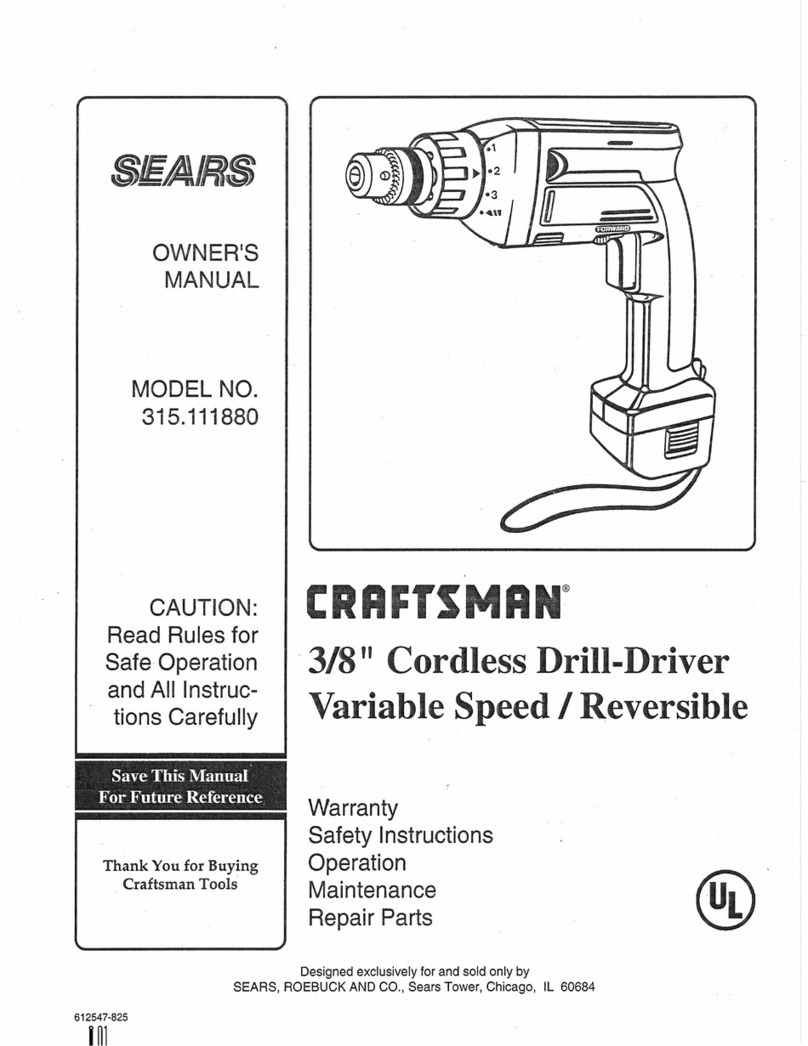
Sears
Sears 315.111880 User manual
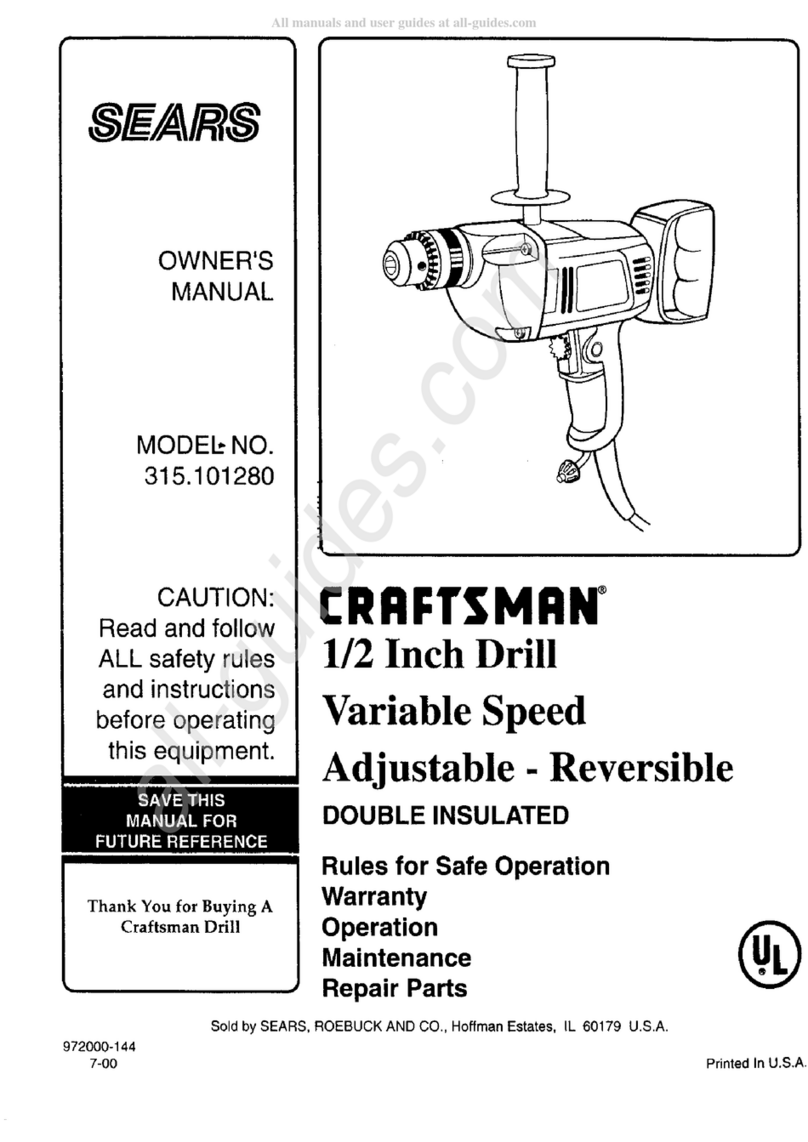
Sears
Sears craftsman 315.101280 User manual
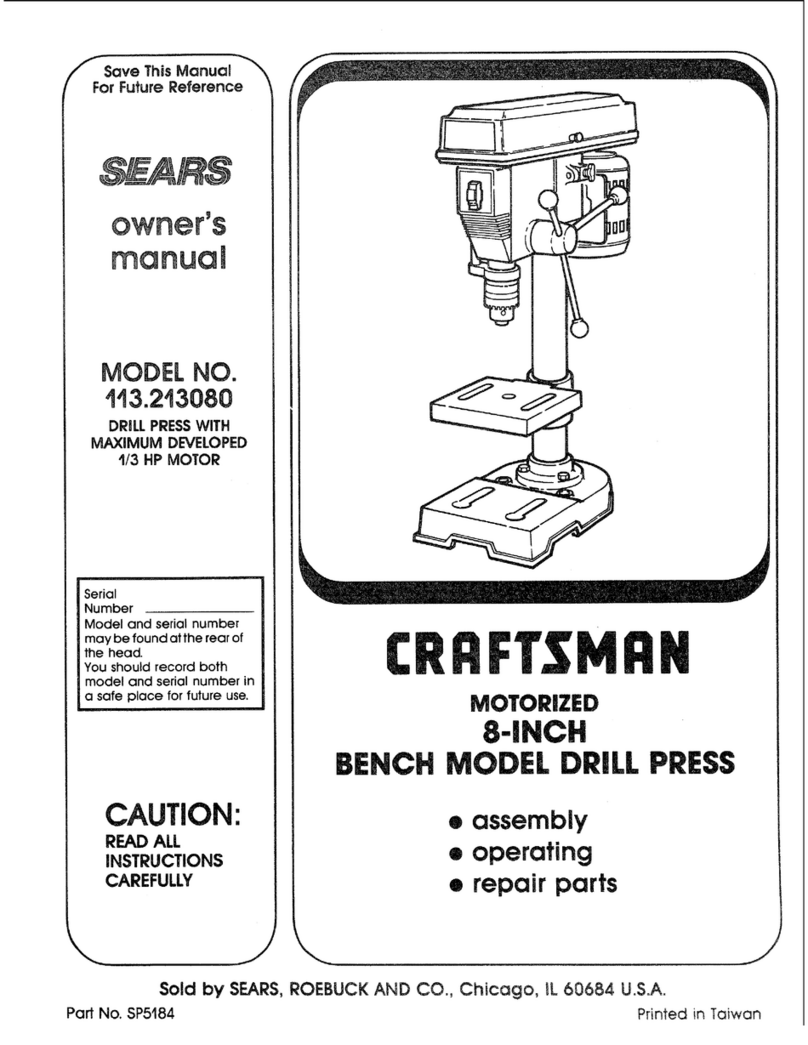
Sears
Sears 113.21308 User manual

Sears
Sears craftsman 315.271900 User manual

Sears
Sears 315.10491 User manual

Sears
Sears Craftsman 315.10280 User manual
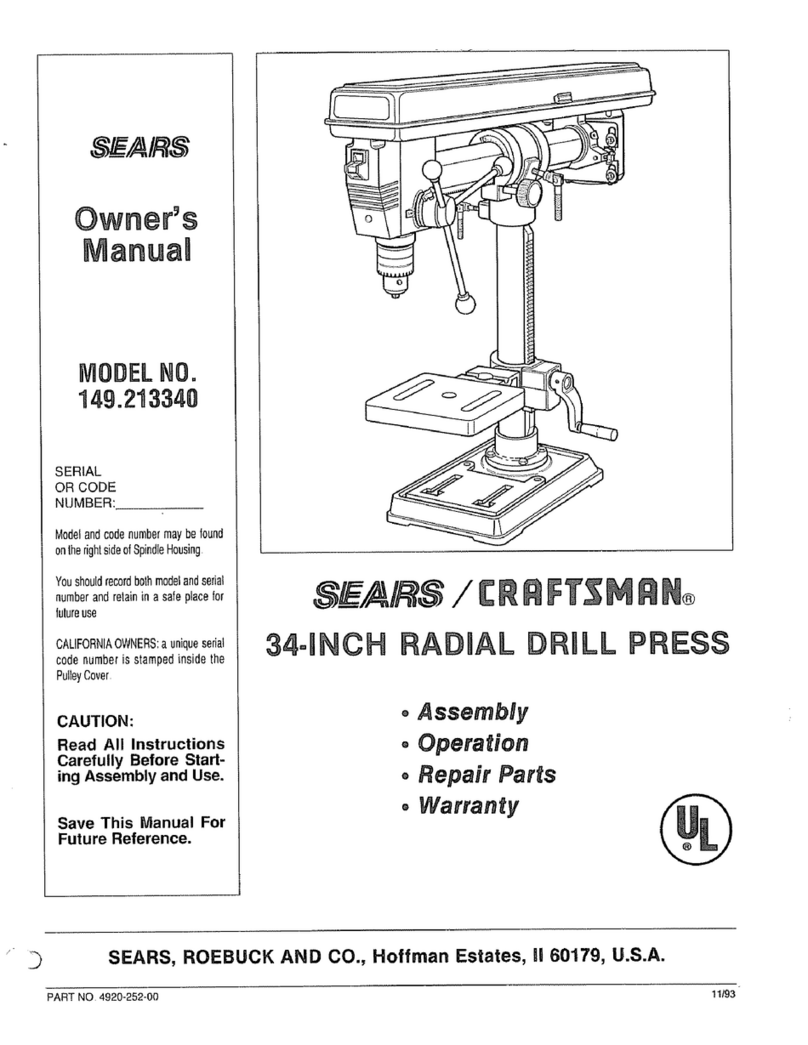
Sears
Sears Craftsman 149.213340 User manual
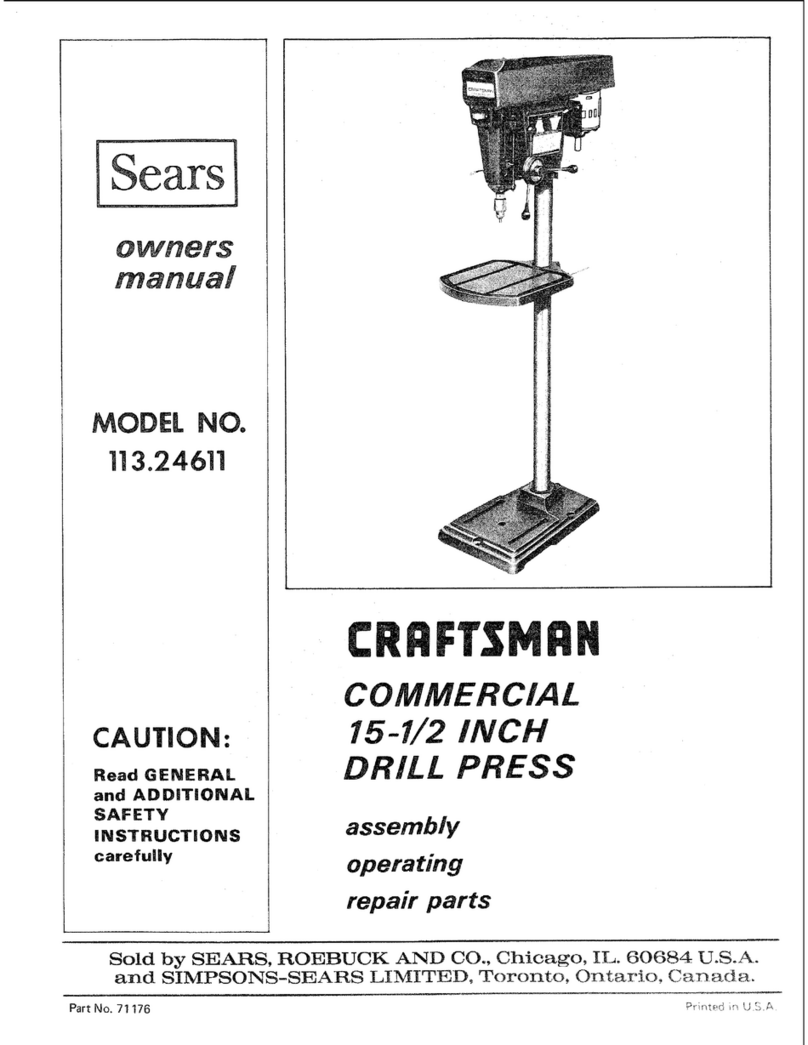
Sears
Sears Craftsman 113.24611 User manual

Sears
Sears 315.10186 User manual

